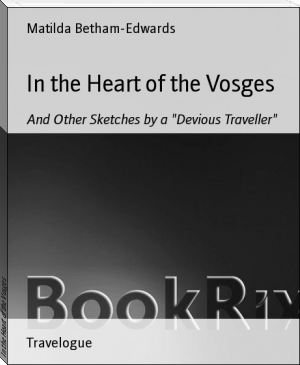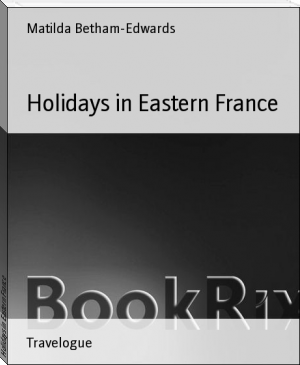In the Heart of the Vosges, Matilda Betham-Edwards [i love reading .txt] 📗

- Author: Matilda Betham-Edwards
Book online «In the Heart of the Vosges, Matilda Betham-Edwards [i love reading .txt] 📗». Author Matilda Betham-Edwards
here manufactured, is a choice liqueur, not the cheap intoxicant of our own public-houses. Liqueurs are always placed with coffee on French breakfast-tables. Every one takes a teaspoonful as a help to digestion.
French people are greatly astonished at the absence of liqueurs in England. The excellence of French digestions generally would not seem to discredit the habit. In the fabrication of gin here only the corn of rye is used, and in small quantities, the juniper berry; it is ready for drinking in six months, although improved by keeping. I saw also curacoa in its various stages. The orange peel used in the manufacture of this liqueur is soaked in alcohol for four months.
My object, however, was to see the high farming on an extensive scale for which this region is famous. Accordingly my host, accompanied by his amiable wife, placed themselves, their carriage, and time at my disposal, and we set out for a long round.
In harvest time the aspect of the country must be one of extreme richness. The enormous sweeps of corn, clover, and beetroot have no division from each other or the road; no hedges are to be seen, and not a tree in the middle of the crops, few trees, indeed, anywhere. Everywhere, on this 17th of April, the corn was a month ahead of former seasons, and, in spite of the long drought, very flourishing.
The first farm visited consists of 360 hectares (just upon 900 acres), all in the highest cultivation, and conducted strictly on the footing of a large industrial concern, with offices, counting-house, carpenters', saddlers' and wheelwrights' shops, smithies, mills and machinery, every agricultural process down to grinding the corn being performed on the premises, and by workmen in the employ of the owner.
As we enter these vast premises, and hear the buzz of machinery, we feel the complete prosaicization of rustic life. The farmhouse scenes of my own childhood in Suffolk, the idyllic descriptions of George Eliot, no more resemble actualities than the poetic spinning-wheel of olden times the loom of latest invention. Utility is the object aimed at, incontestably with great results, but in effect unromantic as Chicago. It is high farming made to pay. All was bustle and activity as we made the round of the premises, beginning with the vast machinery and workshops. These walled-in buildings, divided into two portions, each covering three-quarters of an acre, reminded me of nothing so much as of the caravanserais of Algerian travel twenty-five years ago. Once the doors are bolted none can enter, yet to render security doubly sure dogs are chained up in every corner--we will hope, let loose at night.
I will not here go into agricultural details, only adding a few particulars.
The splendid wheat, clover, bean and rye crops attested the excellence of the farming. Dovetailing into these enormous fields were small patches of peasant owners or tenants, all without division or apparent boundary.
In the villages I was struck by the tidy appearance of the children coming out of school. The usual verdict on peasant proprietors hereabouts was that they do not accumulate, neither are they in want. Very little, if any, beggary meets the eye, either in town or country. We then drove to the chateau, with its English grounds, of the Vicomte de----, friend of my host, and an ardent admirer of England and English ways. This gentleman looked, indeed, like an English squire, and spoke our tongue. He had visited King Edward, then Prince of Wales, at Sandringham. As an illustration of his lavish method of doing things, I mention a quantity of building stone lately ordered from Valenciennes. This stone, for the purpose of building offices, had cost L800. In this part of France clerks and counting-houses seem an indispensable feature of farm premises. An enormous bell for summoning work-people to work or meals is always conspicuous. The whole thing has a commercial aspect.
Here we saw some magnificent animals, among these a prize bull of Flemish breed. It was said to be very fierce, and on this account had a ring in its nose. This cruel custom is now, I believe, prohibited here by the Society for the Prevention of Cruelty to Animals. On the other hand, I was glad to find the Vicomte a member of the kindred society in Paris, and he assured me that he was constantly holding his green card of membership over offenders _in terrorem_.
We hardly expect a rich aristocrat to make utility the first object in his agricultural pursuits. High farming was nevertheless here the order of the day.
We next drove to Clairmarais, a village some miles off in quite another direction, coming in sight of magnificent forests. Our errand was to the ancient Cistercian abbey, now the property of a capitalist, and turned into the business premises of his large farm. Of the original monastery, founded in 1140, hardly a trace remains. Abutting on the outer wall is the chapel, and before it a small enclosed flower-garden full of wallflowers and flowering shrubs, a bit of prettiness welcome to the eye. Just beyond, too, was an old-fashioned, irregularly planted orchard, with young cattle grazing under the bloom-laden trees, the turf dazzlingly bright, but less so than the young corn and rye, now ready for first harvesting.
The vaulted kitchens with vast fireplaces are relics of the ancient abbey, and even now form most picturesque interiors. At a long wooden table in one sat a blue-bloused group drinking cider out of huge yellow mugs--scene for a painter. Another, fitted up as a dairy, was hardly less of a picture. On shelves in the dark, antiquated chamber lay large, red-earthen pans full of cream for cheese-making. The brown-robed figure of a lay brother would have seemed appropriate in either place.
Outside these all was modernization and hard prose. We saw the shepherd returning with his sheep from the herbage, the young lambs bleating pitifully in an inner shed. It is the custom here to send the sheep afield during the day, the lambs meantime being fed on hay. Here again, I should say, is a commercial mistake. The lamb of pasture-fed animals must be incontestably superior. Humanity here seems on the side of utilitarianism. Who can say? Perhaps the inferiority of French meat in certain regions arises from this habit of stabling cattle and sheep. The drive from Clairmarais to St. Omer took us through a quite different and much more attractive country. We were now in the marais, an amphibious stretch of country, cut up into gardens and only accessible by tiny canals. It is a small Holland. This vast stretch of market garden, intersected by waterways just admitting the passage of a boat, is very productive. Three pounds per hectare is often paid in rent. The early vegetables, conveyed by boat to St. Omer, are largely exported to England. Every inch of ground is turned to account, the turf-bordered, canal-bound gardens making a pretty scene, above the green levels intersected by gleaming water the fine towers of St. Omer clearly outlined against the brilliant sky.
The English colony of former days vanished on the outbreak of the last war, not to return. A few young English Catholics still prepare for the priesthood here, and eighty more were at this time pursuing their studies at Douai, under the charge of English Benedictines. "Why," impatiently asked Arthur Young in 1788, "are Catholics to emigrate in order to be ill-educated abroad, instead of being allowed institutions that would educate them well at home?"
The disabilities he reprobates have long since been removed, but English-speaking seminarists still flock to Douai.
Here I close this agricultural and industrial round in Picardy and French Flanders, regions so near home, yet so unfamiliar to most of us! And here I close what, in many respects, may be called another round in unfrequented France.
THE END
Imprint
French people are greatly astonished at the absence of liqueurs in England. The excellence of French digestions generally would not seem to discredit the habit. In the fabrication of gin here only the corn of rye is used, and in small quantities, the juniper berry; it is ready for drinking in six months, although improved by keeping. I saw also curacoa in its various stages. The orange peel used in the manufacture of this liqueur is soaked in alcohol for four months.
My object, however, was to see the high farming on an extensive scale for which this region is famous. Accordingly my host, accompanied by his amiable wife, placed themselves, their carriage, and time at my disposal, and we set out for a long round.
In harvest time the aspect of the country must be one of extreme richness. The enormous sweeps of corn, clover, and beetroot have no division from each other or the road; no hedges are to be seen, and not a tree in the middle of the crops, few trees, indeed, anywhere. Everywhere, on this 17th of April, the corn was a month ahead of former seasons, and, in spite of the long drought, very flourishing.
The first farm visited consists of 360 hectares (just upon 900 acres), all in the highest cultivation, and conducted strictly on the footing of a large industrial concern, with offices, counting-house, carpenters', saddlers' and wheelwrights' shops, smithies, mills and machinery, every agricultural process down to grinding the corn being performed on the premises, and by workmen in the employ of the owner.
As we enter these vast premises, and hear the buzz of machinery, we feel the complete prosaicization of rustic life. The farmhouse scenes of my own childhood in Suffolk, the idyllic descriptions of George Eliot, no more resemble actualities than the poetic spinning-wheel of olden times the loom of latest invention. Utility is the object aimed at, incontestably with great results, but in effect unromantic as Chicago. It is high farming made to pay. All was bustle and activity as we made the round of the premises, beginning with the vast machinery and workshops. These walled-in buildings, divided into two portions, each covering three-quarters of an acre, reminded me of nothing so much as of the caravanserais of Algerian travel twenty-five years ago. Once the doors are bolted none can enter, yet to render security doubly sure dogs are chained up in every corner--we will hope, let loose at night.
I will not here go into agricultural details, only adding a few particulars.
The splendid wheat, clover, bean and rye crops attested the excellence of the farming. Dovetailing into these enormous fields were small patches of peasant owners or tenants, all without division or apparent boundary.
In the villages I was struck by the tidy appearance of the children coming out of school. The usual verdict on peasant proprietors hereabouts was that they do not accumulate, neither are they in want. Very little, if any, beggary meets the eye, either in town or country. We then drove to the chateau, with its English grounds, of the Vicomte de----, friend of my host, and an ardent admirer of England and English ways. This gentleman looked, indeed, like an English squire, and spoke our tongue. He had visited King Edward, then Prince of Wales, at Sandringham. As an illustration of his lavish method of doing things, I mention a quantity of building stone lately ordered from Valenciennes. This stone, for the purpose of building offices, had cost L800. In this part of France clerks and counting-houses seem an indispensable feature of farm premises. An enormous bell for summoning work-people to work or meals is always conspicuous. The whole thing has a commercial aspect.
Here we saw some magnificent animals, among these a prize bull of Flemish breed. It was said to be very fierce, and on this account had a ring in its nose. This cruel custom is now, I believe, prohibited here by the Society for the Prevention of Cruelty to Animals. On the other hand, I was glad to find the Vicomte a member of the kindred society in Paris, and he assured me that he was constantly holding his green card of membership over offenders _in terrorem_.
We hardly expect a rich aristocrat to make utility the first object in his agricultural pursuits. High farming was nevertheless here the order of the day.
We next drove to Clairmarais, a village some miles off in quite another direction, coming in sight of magnificent forests. Our errand was to the ancient Cistercian abbey, now the property of a capitalist, and turned into the business premises of his large farm. Of the original monastery, founded in 1140, hardly a trace remains. Abutting on the outer wall is the chapel, and before it a small enclosed flower-garden full of wallflowers and flowering shrubs, a bit of prettiness welcome to the eye. Just beyond, too, was an old-fashioned, irregularly planted orchard, with young cattle grazing under the bloom-laden trees, the turf dazzlingly bright, but less so than the young corn and rye, now ready for first harvesting.
The vaulted kitchens with vast fireplaces are relics of the ancient abbey, and even now form most picturesque interiors. At a long wooden table in one sat a blue-bloused group drinking cider out of huge yellow mugs--scene for a painter. Another, fitted up as a dairy, was hardly less of a picture. On shelves in the dark, antiquated chamber lay large, red-earthen pans full of cream for cheese-making. The brown-robed figure of a lay brother would have seemed appropriate in either place.
Outside these all was modernization and hard prose. We saw the shepherd returning with his sheep from the herbage, the young lambs bleating pitifully in an inner shed. It is the custom here to send the sheep afield during the day, the lambs meantime being fed on hay. Here again, I should say, is a commercial mistake. The lamb of pasture-fed animals must be incontestably superior. Humanity here seems on the side of utilitarianism. Who can say? Perhaps the inferiority of French meat in certain regions arises from this habit of stabling cattle and sheep. The drive from Clairmarais to St. Omer took us through a quite different and much more attractive country. We were now in the marais, an amphibious stretch of country, cut up into gardens and only accessible by tiny canals. It is a small Holland. This vast stretch of market garden, intersected by waterways just admitting the passage of a boat, is very productive. Three pounds per hectare is often paid in rent. The early vegetables, conveyed by boat to St. Omer, are largely exported to England. Every inch of ground is turned to account, the turf-bordered, canal-bound gardens making a pretty scene, above the green levels intersected by gleaming water the fine towers of St. Omer clearly outlined against the brilliant sky.
The English colony of former days vanished on the outbreak of the last war, not to return. A few young English Catholics still prepare for the priesthood here, and eighty more were at this time pursuing their studies at Douai, under the charge of English Benedictines. "Why," impatiently asked Arthur Young in 1788, "are Catholics to emigrate in order to be ill-educated abroad, instead of being allowed institutions that would educate them well at home?"
The disabilities he reprobates have long since been removed, but English-speaking seminarists still flock to Douai.
Here I close this agricultural and industrial round in Picardy and French Flanders, regions so near home, yet so unfamiliar to most of us! And here I close what, in many respects, may be called another round in unfrequented France.
THE END
Imprint
Publication Date: 08-27-2010
All Rights Reserved
Free e-book «In the Heart of the Vosges, Matilda Betham-Edwards [i love reading .txt] 📗» - read online now
Similar e-books:





Comments (0)